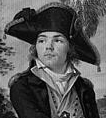General Jean Baptiste Cacault

Born: January 6, 1769
Place of Birth: Surgères, Charente-Maritime, France
Died: September 30, 1813
Cause of Death: Mortally wounded
Place of Death: Torgau, Germany
Arc de Triomphe: CACAULT on the south pillar
Pronunciation:
The son of a baker, Jean Baptiste Cacault enlisted in the infantry regiment of Rouergue in 1784 and four years later he was promoted to sergeant. In 1790 and 1791 he served in Martinique and then in 1792 he served back in France with the Army of the Center and the Army of the Ardennes. In January of 1794 Cacault was fighting and he was wounded by multiple saber blows but it earned him a promotion to chef de bataillon. That April he distinguished himself at the combat of Boussus-les-Walcourt and he was promoted to chef de brigade on the battlefield. The next month Cacault served at the action of Thuin and then in July he joined the Army of the Sambre and Meuse. In 1795 he was put on non-activity and he finally was reintegrated into the army four years later in August of 1799 as commander of the département of Pyrénées-Orientales. From 1799 to 1801 Cacault served with the Army of Italy, and during that time in April of 1800 he became chief of staff of Pouget's division. He also served during the blockade of Fort Finale in Liguria.
In September of 1801 Cacault was put on non-activity but then in September of 1802 he was given command of the arrondissement of Worms in the 26th military division. In 1804 he was named an Officer of the Legion of Honor and in 1805 he was employed in the 8th military division. After the campaign began later that year, Cacault became General Reynier's chief of staff in the Army of Italy at the end of October. In 1806 he served as chief of staff to Verdier for a period of time but in October he was called to the Grande Armée where he joined the staff. At the end of the year Cacault joined Marshal Ney's VI Corps and he fought at the Battle of Eylau in February of 1807. Next he went on to serve at the Siege of Danzig where he was wounded in the right arm and he was attached to General Rapp's staff.
Cacault went on leave in February of 1808 but he returned to the army in October to join the Army of Spain. However, in March he was ordered to go to Germany to join the II Corps due to the possibility of war with Austria. During the campaign that followed, he served at the Battle of Wagram and afterwards he was named a Commander of the Order of Charles Frederick of Baden and promoted to général de brigade. Cacault was next sent to Antwerp and then to northern Spain. In January of 1810 he joined the 3rd Division of VIII Corps, serving under General Junot in the Army of Portugal. That March Cacault was named commander of Vieille Castille and in April he was named a Baron of the Empire. In July he became commander at Ciudad-Rodrigo where he would remain for the next year until he was accused of corruption and was put on non-activity. In February of 1812 Cacault was recalled to activity to serve as commander of the isle of Aix and then in July he took command of the département of Ille-et-Vilaine.
For the campaign in Saxony of 1813, Cacault was employed in Compans' division which would become the 20th Division of Marshal Marmont's VI Corps. In May he fought at the Battle of Lützen and then in August he took command of the 2nd Brigade of Pacthod's 13th Division in Marshal Oudinot's XII Corps. On September 6th he fought at the Battle of Dennewitz and had his left hand carried away by a ball at Juterbock. Transported to Torgau the next day, his left arm was then amputated. However, he died from his wounds at the end of the month.
Bibliography
- Divry, Arnauld. Les Noms Gravés sur l'Arc de Triomphe. Paris: L'Harmattan, 2017.
- Six, Georges. Dictionnaire Biographique des Généraux & Amiraux Français de la Révolution et de l'Empire (1792-1814). 2 vols. Paris: Gaston Saffroy, 2003.
Updated December 2019
© Nathan D. Jensen